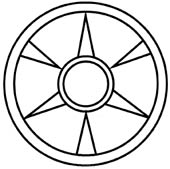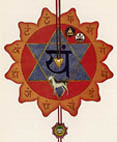3. The Alchemical Rosarium
Philosophorum
3.4 The archetypal child and the seal of Solomon as
the fourth
In
the Rosarium we have however a completely different situation. In it,
the opposition of the sexes of the two divine figures is presented to us.
Because the king as well as the queen possess the quality of royalty or even
of divinity, it is impossible to assign one of these figures to
consciousness. Therefore,
the opposition of the king and the queen in the
fountain of Mercury in which the Holy Wedding will take place describes a
conflict
in
what
Carl
Jung
calls
the
collective
unconscious
or
even
in
the
unus
mundus,
and
also
its
necessary
solution
resides there.
We
will later see that this situation leads to an extension of Carl Jung’s
depth psychology. What he calls the Self, I will call the Logos Self, i.e.,
the collective spirit-psyche that is represented here by the king. Behind it
there exists an even deeper realm – I will call it the Eros Self – a
feminine principle, the collective matter-psyche, that is of the same value
as the masculine.
I would like to stress already here that only with such an assumption we
will be able to translate the energetical process represented by the
alchemical Rosarium’s Holy
Wedding into a modern language.
When
we compare the Holy Wedding with man’s sexuality, there arises a further
difficulty. Namely, if one understands the coniunctio
as a process that takes place between the queen, the king,
and the
ambivalent Mercury, then the reader will have figured out that the child
actually represents not the third, but the fourth. The
creation of the fourth is however a problem that alchemy was occupied with
very intensely. It is represented by the famous Axiom
of Maria Prophetissa: "One becomes two, two becomes three, and out of the
third comes the One as the fourth.”
 As
I have described elsewhere,
the decisive aspect of the Axiom is the fact that with the expression “out
of the third comes the One” it states implicitly that the third is split.
The dove that I interpret as the ambivalent Mercury, being matter as well as
spirit, fits very well in that picture. It seems therefore that the Holy
Wedding serves the purpose of the creation of the fourth that overcomes the
opposites in Mercury itself.
This
fourth, the archetypal child of the coniunctio, is the hexagonal structure
of flowers, represented
in the above picture (see section 3.2) and also in other ones (see picture on the left; 3rd
picture of Jung’s essay). The fourth is
thus symbolized by a vegetative symbol. As we will later see,
this interpretation is backed by the fact that in the moment of the coniunctio
the creation myth described in the Rosarium
will change from an instinctive to a vegetative one, which means of
course that the child must be some vegetative being.
As
I have described elsewhere,
the decisive aspect of the Axiom is the fact that with the expression “out
of the third comes the One” it states implicitly that the third is split.
The dove that I interpret as the ambivalent Mercury, being matter as well as
spirit, fits very well in that picture. It seems therefore that the Holy
Wedding serves the purpose of the creation of the fourth that overcomes the
opposites in Mercury itself.
This
fourth, the archetypal child of the coniunctio, is the hexagonal structure
of flowers, represented
in the above picture (see section 3.2) and also in other ones (see picture on the left; 3rd
picture of Jung’s essay). The fourth is
thus symbolized by a vegetative symbol. As we will later see,
this interpretation is backed by the fact that in the moment of the coniunctio
the creation myth described in the Rosarium
will change from an instinctive to a vegetative one, which means of
course that the child must be some vegetative being.
In
an abstract language, the above interpretation [see also I Cercatori di Dio] means that the
fourth corresponds to the number six, respectively
to a double-triad, and that this fourth has something to do with a
vegetative creation myth.
As
the radius of the circle is equal to the length of one of the sides of the
hexagon, number six is intimately connected to the circle. A necessary
conclusion of this fact is that the fourth does not correspond to number 4
and the square, as most Jungians believe. Further, only the
inclusion of the circle makes the quadrature of the circle possible.
As this geometrical operation is a very important symbol of the alchemical
opus’ goal, the inclusion of the circle as the fourth is absolutely
important for the understanding of a modern interpretation of (Hermetic)
alchemy.
Because
collective consciousness wars against every true innovation, it eventually
finds itself confused when the new revolutionary idea begins to manifest.
This is the real reason why, as mentioned in the
above Jung quote, the archetypal child – which I define now as the fourth
and not as the third – , the symbol of the future development and new
life, repressed by the collective consciousness, is always connected with
abandonment, loneliness, danger and persecution. Thus, if a creative human
has the challenge of dealing with this child archetype constellated in him,
but does not succeed or is too lazy to do it, there exists always the danger
of the outbreak of severe illness; but also many psychosomatic disturbances
can be attributed to the unconsciousness due to the necessary inclusion of
the child archetype in one’s individuation process.
 After
my conclusions above, it is not too astonishing anymore, that the archetypal
child, the goal of the opus (the work), is also symbolized as the so-called rotundum,
the round thing. Of course it is equivalent to number six, which – as we
have
After
my conclusions above, it is not too astonishing anymore, that the archetypal
child, the goal of the opus (the work), is also symbolized as the so-called rotundum,
the round thing. Of course it is equivalent to number six, which – as we
have seen above
– results through the division of the circle with the help of
its
radius. From this hexagon the seal of Solomon is deduced, the so-called Star of David, that characterizes both
the opus and
its
goal (see figure on the left).
Gershom Sholem, the well-known
researcher of Jewish myth has shown that despite the common belief, this
symbol is not originally Jewish (see also Rome
lecture).
seen above
– results through the division of the circle with the help of
its
radius. From this hexagon the seal of Solomon is deduced, the so-called Star of David, that characterizes both
the opus and
its
goal (see figure on the left).
Gershom Sholem, the well-known
researcher of Jewish myth has shown that despite the common belief, this
symbol is not originally Jewish (see also Rome
lecture).  Actually, one will find it in the mysticism of all
five world religions: in the Kabbalah, in Christian mysticism – Nicholas
von Flue’s image of the wheel (see figure on the right) – ,
in the heart chakra of Buddhist and Hindu Tantrism (see picture on the left)
and in Muslim Sufism. It is always connected to the heart, the symbol of the
Eros principle in the original and broadest sense of the word (see below).
Actually, one will find it in the mysticism of all
five world religions: in the Kabbalah, in Christian mysticism – Nicholas
von Flue’s image of the wheel (see figure on the right) – ,
in the heart chakra of Buddhist and Hindu Tantrism (see picture on the left)
and in Muslim Sufism. It is always connected to the heart, the symbol of the
Eros principle in the original and broadest sense of the word (see below).
Thus,
it should further not be surprising that the number six appears, as we have
seen, not only in the second picture of the Rosarium
but also in many further ones. In the first picture, for example, number six
is present in the six stars at the fountain of Mercury; in the fourth
picture (see below) the fountain in which the transformation happens is a
hexagon.
It
seems therefore that the repetition of this specific symbolism points out
that the number 6 constitutes a very important attribute of this process. As
it appears already in the beginning of the opus, number six is closely
linked with the so-called prima
materia (the opposition of the king and the queen) as well as with their
end product, the infans solaris.
It characterizes the fountain of Mercury and the God Mercury itself, who is
the central archetype of (Hermetic) alchemy. As we will see, the Rosarium
deals with the archetypal or even psychophysical background of
sexuality. Thus, it eventually addresses also the Sixth
Commandment of the Old Testament (“Thou shalt not commit adultery”),
which deals exactly with this basic human drive. Further, we can conclude
here that a
rejection of the symbol of the fourth as the number six ultimately
corresponds to a refusal of the inclusion of the problem of sexuality in
one’s own individuation process.
This conclusion leads us back to my first remarks about my
experiences at the C.G. Jung Institute at Zurich. We recognize now that in
it, more than 30 years ago, the fourth was equated with number four,
and thus the whole sexual problem was repressed. The psychological law of
enantiodromia tells us however, that a repression tends to develop into an
identification with the repressed subject. As America is always a bit faster
than “Old Europe”, we can see this development now in certain Jungian
circles there: Trainees begin to have sex with a stranger and believe that
like this they can open themselves up to the coniunctio
mysticism as a part of the analytical training! The fourth as “number sex” has unconsciously
taken possession of them…!
[proofread
GJS, 4/20/05]